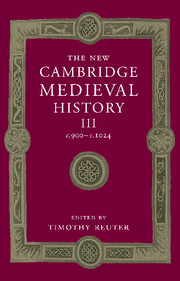Book contents
- Frontmatter
- 1 Introduction: reading the tenth century
- PART I GENERAL THEMES
- PART II POST-CAROLINGIAN EUROPE
- 9 The Ottonians as kings and emperors
- 10 Saxony and the Elbe Slavs in the tenth century
- 11 Bavaria in the tenth and early eleventh centuries
- 12 Lotharingia
- 13 Burgundy and Provence, 879–1032
- 14 The kingdom of Italy
- 15 West Francia: the kingdom
- 16 West Francia: the northern principalities
- 17 Western Francia: the southern principalities
- 18 England, c. 900–1016
- PART III NON-CAROLINGIAN EUROPE
- Appendix genealogical tables
- List of primary sources
- Bibliography of secondary works arranged by chapter
- Index
- Frontispiece
- Plate section
- Map 2: Archbishoprics and bishoprics in the early eleventh century
- Map 4: Germany
- Map 13: Byzantium in 1025
- References
13 - Burgundy and Provence, 879–1032
from PART II - POST-CAROLINGIAN EUROPE
Published online by Cambridge University Press: 28 March 2008
- Frontmatter
- 1 Introduction: reading the tenth century
- PART I GENERAL THEMES
- PART II POST-CAROLINGIAN EUROPE
- 9 The Ottonians as kings and emperors
- 10 Saxony and the Elbe Slavs in the tenth century
- 11 Bavaria in the tenth and early eleventh centuries
- 12 Lotharingia
- 13 Burgundy and Provence, 879–1032
- 14 The kingdom of Italy
- 15 West Francia: the kingdom
- 16 West Francia: the northern principalities
- 17 Western Francia: the southern principalities
- 18 England, c. 900–1016
- PART III NON-CAROLINGIAN EUROPE
- Appendix genealogical tables
- List of primary sources
- Bibliography of secondary works arranged by chapter
- Index
- Frontispiece
- Plate section
- Map 2: Archbishoprics and bishoprics in the early eleventh century
- Map 4: Germany
- Map 13: Byzantium in 1025
- References
Summary
the region known as Burgundy has had some of the most elastic borders of any region of France, and some of the various regions called ‘Burgundy’ at different times barely overlap at all. The name comes from the tribe of the Burgundians, who in the fifth century established a kingdom centred in the region between Geneva and Lyons, which kingdom stretched south towards Arles. After this kingdom was conquered by the sons of Clovis in the 530s, ‘Burgundy’ became one of the three principal Frankish kingdoms (with Neustria and Austrasia) and covered essentially all the Loire and Saône–Rhône river basins, stretching from its capital at Orléans to the Mediterranean.
A somewhat diminished version of this Merovingian kingdom of Burgundy was divided between the sons of Louis the Pious in 843. Charles the Bald of France received the western part, essentially the region between the Saône and the Loire, reaching from Sens and Troyes south to Autun and Mâcon. This is the region which later (and without Sens and Troyes) became the French duchy of Burgundy. French Burgundy, and indeed the entire French regnum, was divided from imperial territory by the Rhône–Saône river basin. At various times and in various places both French Burgundy and imperial Burgundy reached across to the other side of the river, and south of Mâcon imperial Burgundy was often considered to include at least a narrow strip of the river system’s west bank, but for the most part these rivers can be considered the dividing line between the two Burgundies, French and imperial, which were permanently separated after 843.
- Type
- Chapter
- Information
- The New Cambridge Medieval History , pp. 328 - 345Publisher: Cambridge University PressPrint publication year: 2000



